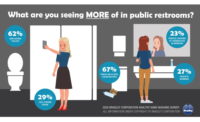Green homes market to increase five-fold by 2016
Green
homes comprised 17% of the overall residential construction market in 2011 and
are expected to grow to between 29% and 38% of the market by 2016, according to
a Green Home Builders and Remodelers Study by McGraw-Hill Construction. By
value, this equates to a five-fold increase, growing from $17 billion in 2011
to $87-$114 billion in 2016, based on the five-year forecast for overall
residential construction.
According to the study, construction industry professionals report an even steeper increase in green home remodeling; 34% of remodelers expect to be doing mostly green work by 2016, a 150% increase over 2011 activity levels. Many home builders have shifted to the remodeling market due to the drastic drop in new home construction. In fact, 62% of the builders who do both new and remodeling work verified that the economy has increased their renovation work.
Many factors are driving the green homes market, with “higher quality” and “increases in energy costs” topping the list, indicating that today’s green homebuyer is not just a green consumer. Buyers recognize that green homes have lower bills due to higher building performance. The reported costs of building a green home have also gone down significantly. Builders report that the cost to go green is now 7%, as compared to 10% in 2008 and 11% in 2006.
“The housing market is critical to the U.S. economy,” said Harvey M. Bernstein, vice president of industry insights and alliances, McGraw-Hill Construction, “and the results of our study show that despite the drastic downturn in housing starts since 2008, green has grown significantly as a share of activity - indicating that the green market is becoming an important part of our overall economic landscape.”
The green home building study, produced by McGraw-Hill Construction in conjunction with the National Association of Home Builders and Waste Management, is designed to provide key insights into market opportunities. The study reveals business benefits afforded by green building, such as a competitive marketing advantage: 46% of builders and remodelers find that “building green” makes it easier to market themselves in a down economy, and an overwhelming 71% of firms that are dedicated to green home building report the same.
“In a sample of NAHB builder and remodeler members, nearly 90% reported building green at some level,” said NAHB Chairman Barry Rutenberg, a home builder from Gainesville, Fla. “This is a powerful testament to the importance of green home building - and transforms the way we think of homes overall.”
By 2016, many more builders anticipate that they will be dedicated to green building work on over 90% of projects - 33% expect to be dedicated to green work in 2016, up from 17% in 2011. Remodeling will grow even more dramatically - 22% of remodelers report that they anticipate they will be dedicated to green work in 2016, nearly triple the 8% who report being dedicated to green work in 2011. These builders are clued into the revenue opportunity afforded by green building and know that home buyers will pay more for green homes, according to 61% of builders and 66% of remodelers.
“Home buyers and builders increasingly want to do what’s right for the environment,” said Jim Halter, vice president for construction solutions, Waste Management. “This trend has been taking off within our business as customers look to recycle and divert more materials from landfills.”
While green is growing across the U.S., three regions are seeing higher than average growth. The West Coast has seen the highest green growth; the Midwest’s northern region, west of the Mississippi, is second highest; and New England ranks third.
McGraw-Hill Construction will continue analyzing the results of the Green Home Builders and Remodelers Study and release a printed report in April, including remodeling details, green technologies and green product adoption in green homes.
According to the study, construction industry professionals report an even steeper increase in green home remodeling; 34% of remodelers expect to be doing mostly green work by 2016, a 150% increase over 2011 activity levels. Many home builders have shifted to the remodeling market due to the drastic drop in new home construction. In fact, 62% of the builders who do both new and remodeling work verified that the economy has increased their renovation work.
Many factors are driving the green homes market, with “higher quality” and “increases in energy costs” topping the list, indicating that today’s green homebuyer is not just a green consumer. Buyers recognize that green homes have lower bills due to higher building performance. The reported costs of building a green home have also gone down significantly. Builders report that the cost to go green is now 7%, as compared to 10% in 2008 and 11% in 2006.
“The housing market is critical to the U.S. economy,” said Harvey M. Bernstein, vice president of industry insights and alliances, McGraw-Hill Construction, “and the results of our study show that despite the drastic downturn in housing starts since 2008, green has grown significantly as a share of activity - indicating that the green market is becoming an important part of our overall economic landscape.”
The green home building study, produced by McGraw-Hill Construction in conjunction with the National Association of Home Builders and Waste Management, is designed to provide key insights into market opportunities. The study reveals business benefits afforded by green building, such as a competitive marketing advantage: 46% of builders and remodelers find that “building green” makes it easier to market themselves in a down economy, and an overwhelming 71% of firms that are dedicated to green home building report the same.
“In a sample of NAHB builder and remodeler members, nearly 90% reported building green at some level,” said NAHB Chairman Barry Rutenberg, a home builder from Gainesville, Fla. “This is a powerful testament to the importance of green home building - and transforms the way we think of homes overall.”
By 2016, many more builders anticipate that they will be dedicated to green building work on over 90% of projects - 33% expect to be dedicated to green work in 2016, up from 17% in 2011. Remodeling will grow even more dramatically - 22% of remodelers report that they anticipate they will be dedicated to green work in 2016, nearly triple the 8% who report being dedicated to green work in 2011. These builders are clued into the revenue opportunity afforded by green building and know that home buyers will pay more for green homes, according to 61% of builders and 66% of remodelers.
“Home buyers and builders increasingly want to do what’s right for the environment,” said Jim Halter, vice president for construction solutions, Waste Management. “This trend has been taking off within our business as customers look to recycle and divert more materials from landfills.”
While green is growing across the U.S., three regions are seeing higher than average growth. The West Coast has seen the highest green growth; the Midwest’s northern region, west of the Mississippi, is second highest; and New England ranks third.
McGraw-Hill Construction will continue analyzing the results of the Green Home Builders and Remodelers Study and release a printed report in April, including remodeling details, green technologies and green product adoption in green homes.
Looking for a reprint of this article?
From high-res PDFs to custom plaques, order your copy today!




